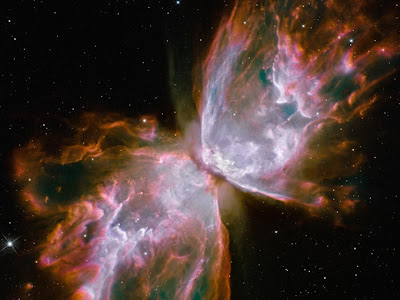Hubble image. NASA
When we admire the stunning images of God's work of creation taken by the Hubble space telescope we see light, some emitted, some absorbed, some reflected some bent, some filtered...
This light (and other forms of EM radiation) comes from many different sources the identification which is the bread and butter of astronomy research.
Light illuminates those enormous nebulas, clouds of matter. The entire cosmos is visible to our eyes and to our instruments because of the photons and other particles that are emitted when energy interacts with matter.
Matter matters
Different fields use the term in different and sometimes incompatible ways; there is no single agreed scientific meaning of the word matter.
A common way of defining matter is anything that has mass and volume.
- Mass is the amount of matter in an object
- volume is the amount of space occupied by an object.
Matter is a general term for the substance of which all physical objects consist. Typically, matter includes atoms and other particles which have mass.
Matter may be defined as anything that
- occupies space
- possesses mass
- offers resistance
- can be felt by one or more of our senses
Four states of matter
Matter is commonly said to exist in four states:
- solid
- liquid
- gas
- plasma
Advances in experimental techniques have realized other states, previously only theoretical constructs
- Bose–Einstein condensates
- fermionic condensates.
A focus on an elementary-particle view of matter also leads to new states of matter, such as the
- quark–gluon plasma.
Duality of matter
In physics and chemistry, matter exhibits both wave-like and particle-like properties, the so-called wave–particle duality
Space matter
In the realm of cosmology, extensions of the term matter are invoked to include
- dark matter
- dark energy
concepts introduced to explain some odd phenomena of the observable universe, such as the galactic rotation curve.
These exotic forms of "matter" do not refer to matter as "building blocks", but rather to currently poorly understood forms of mass and energy.
(Text on this posting is based on the wikipedia article on matter)

No comments:
Post a Comment